Accounting Fundamentals: Ledger, Trial Balance, Statements
VerifiedAdded on 2023/01/17
|21
|3340
|62
Homework Assignment
AI Summary
This accounting assignment provides a comprehensive overview of accounting fundamentals. It begins with an introduction to key concepts and then delves into practical applications through several tasks. Task 1 covers journal entries, ledger accounts, trial balance, and the preparation of financial statements, including the income statement and balance sheet. Tasks 2, 3, and 4 present detailed ledger accounts, trial balances, and financial statements for different entities (Pendo, Mafuta, and Ricardo), demonstrating the application of accounting principles in various scenarios. Task 5 focuses on capital expenditure. The assignment concludes with a discussion of the concepts covered and references used, providing a solid foundation in financial accounting principles. This assignment is ideal for students seeking to understand how to prepare financial statements and analyze financial positions.

ACCOUNTING
FUNDAMENTALS
FUNDAMENTALS
Paraphrase This Document
Need a fresh take? Get an instant paraphrase of this document with our AI Paraphraser
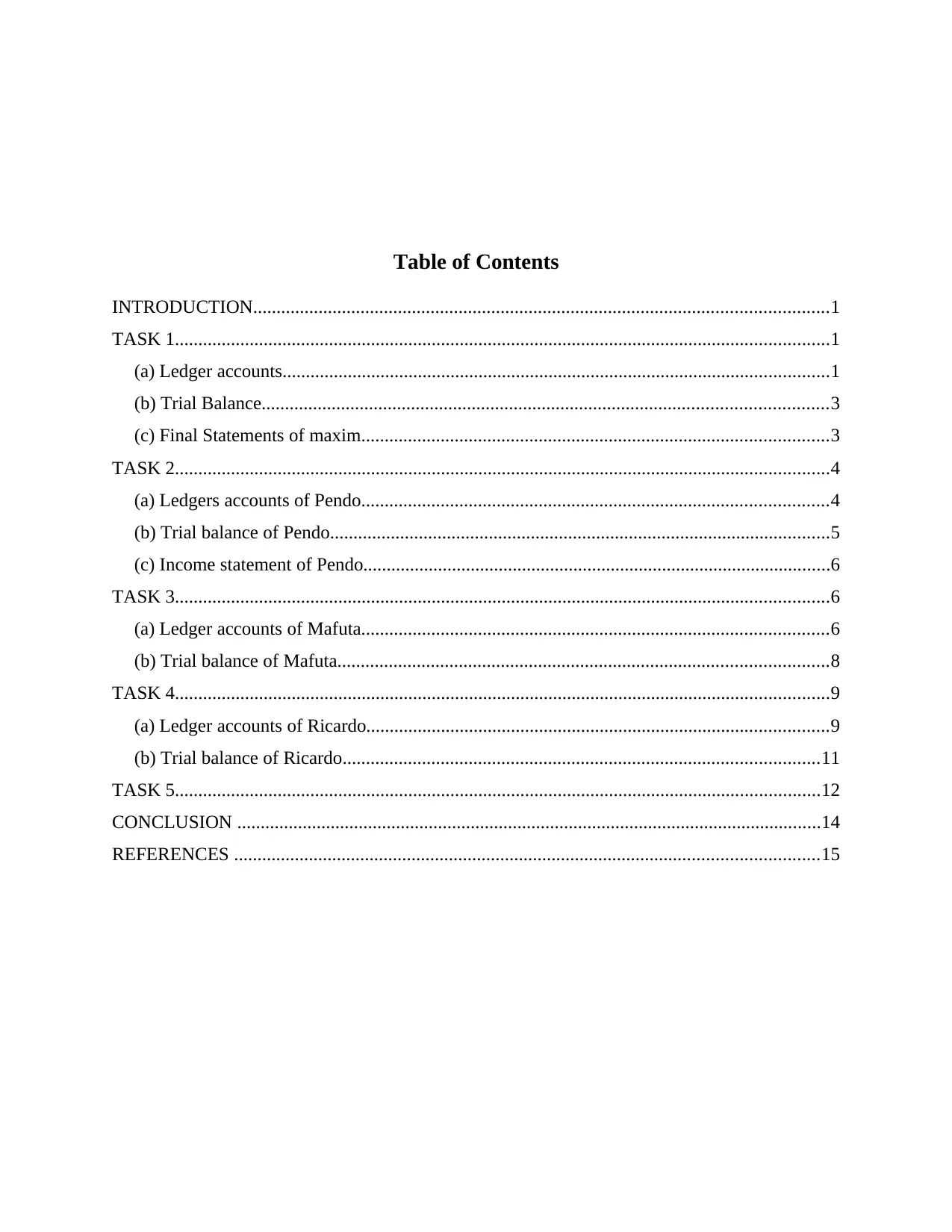
Table of Contents
INTRODUCTION...........................................................................................................................1
TASK 1............................................................................................................................................1
(a) Ledger accounts.....................................................................................................................1
(b) Trial Balance.........................................................................................................................3
(c) Final Statements of maxim....................................................................................................3
TASK 2............................................................................................................................................4
(a) Ledgers accounts of Pendo....................................................................................................4
(b) Trial balance of Pendo...........................................................................................................5
(c) Income statement of Pendo....................................................................................................6
TASK 3............................................................................................................................................6
(a) Ledger accounts of Mafuta....................................................................................................6
(b) Trial balance of Mafuta.........................................................................................................8
TASK 4............................................................................................................................................9
(a) Ledger accounts of Ricardo...................................................................................................9
(b) Trial balance of Ricardo......................................................................................................11
TASK 5..........................................................................................................................................12
CONCLUSION .............................................................................................................................14
REFERENCES .............................................................................................................................15
INTRODUCTION...........................................................................................................................1
TASK 1............................................................................................................................................1
(a) Ledger accounts.....................................................................................................................1
(b) Trial Balance.........................................................................................................................3
(c) Final Statements of maxim....................................................................................................3
TASK 2............................................................................................................................................4
(a) Ledgers accounts of Pendo....................................................................................................4
(b) Trial balance of Pendo...........................................................................................................5
(c) Income statement of Pendo....................................................................................................6
TASK 3............................................................................................................................................6
(a) Ledger accounts of Mafuta....................................................................................................6
(b) Trial balance of Mafuta.........................................................................................................8
TASK 4............................................................................................................................................9
(a) Ledger accounts of Ricardo...................................................................................................9
(b) Trial balance of Ricardo......................................................................................................11
TASK 5..........................................................................................................................................12
CONCLUSION .............................................................................................................................14
REFERENCES .............................................................................................................................15

⊘ This is a preview!⊘
Do you want full access?
Subscribe today to unlock all pages.

Trusted by 1+ million students worldwide
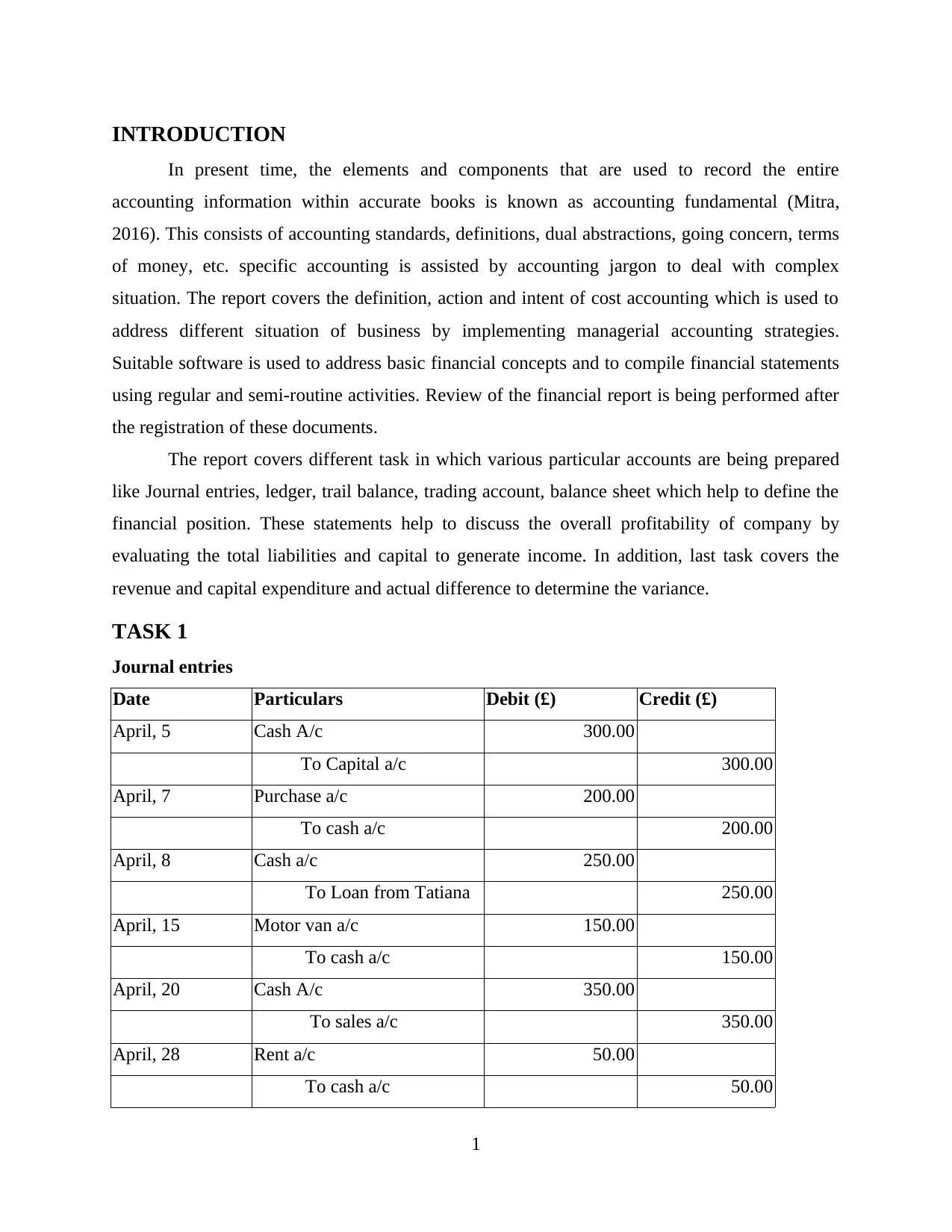
INTRODUCTION
In present time, the elements and components that are used to record the entire
accounting information within accurate books is known as accounting fundamental (Mitra,
2016). This consists of accounting standards, definitions, dual abstractions, going concern, terms
of money, etc. specific accounting is assisted by accounting jargon to deal with complex
situation. The report covers the definition, action and intent of cost accounting which is used to
address different situation of business by implementing managerial accounting strategies.
Suitable software is used to address basic financial concepts and to compile financial statements
using regular and semi-routine activities. Review of the financial report is being performed after
the registration of these documents.
The report covers different task in which various particular accounts are being prepared
like Journal entries, ledger, trail balance, trading account, balance sheet which help to define the
financial position. These statements help to discuss the overall profitability of company by
evaluating the total liabilities and capital to generate income. In addition, last task covers the
revenue and capital expenditure and actual difference to determine the variance.
TASK 1
Journal entries
Date Particulars Debit (£) Credit (£)
April, 5 Cash A/c 300.00
To Capital a/c 300.00
April, 7 Purchase a/c 200.00
To cash a/c 200.00
April, 8 Cash a/c 250.00
To Loan from Tatiana 250.00
April, 15 Motor van a/c 150.00
To cash a/c 150.00
April, 20 Cash A/c 350.00
To sales a/c 350.00
April, 28 Rent a/c 50.00
To cash a/c 50.00
1
In present time, the elements and components that are used to record the entire
accounting information within accurate books is known as accounting fundamental (Mitra,
2016). This consists of accounting standards, definitions, dual abstractions, going concern, terms
of money, etc. specific accounting is assisted by accounting jargon to deal with complex
situation. The report covers the definition, action and intent of cost accounting which is used to
address different situation of business by implementing managerial accounting strategies.
Suitable software is used to address basic financial concepts and to compile financial statements
using regular and semi-routine activities. Review of the financial report is being performed after
the registration of these documents.
The report covers different task in which various particular accounts are being prepared
like Journal entries, ledger, trail balance, trading account, balance sheet which help to define the
financial position. These statements help to discuss the overall profitability of company by
evaluating the total liabilities and capital to generate income. In addition, last task covers the
revenue and capital expenditure and actual difference to determine the variance.
TASK 1
Journal entries
Date Particulars Debit (£) Credit (£)
April, 5 Cash A/c 300.00
To Capital a/c 300.00
April, 7 Purchase a/c 200.00
To cash a/c 200.00
April, 8 Cash a/c 250.00
To Loan from Tatiana 250.00
April, 15 Motor van a/c 150.00
To cash a/c 150.00
April, 20 Cash A/c 350.00
To sales a/c 350.00
April, 28 Rent a/c 50.00
To cash a/c 50.00
1
Paraphrase This Document
Need a fresh take? Get an instant paraphrase of this document with our AI Paraphraser

April, 29 Loan a/c 200.00
To Cash A/c 200
April, 30 Drawings a/c 60.00
To cash a/c 60.00
(a) Ledger accounts
Cash a/c
Date Particular Amount Date Particular Amount
05/04/18 To capital a/c 300.00 07/04/18 By purchase 200.00
08/04/18
To loan form
Tatiana 250.00 15/04/18 By Motor van 150.00
20/04/18 To sales 350.00 28/04/18 By rent 50.00
29/04/18 By loan paid 200.00
30/04/18 by Drawing 60.00
30/04/18
By closing
balance 240.00
900.00 900.00
Capital a/c
Date Particular Amount Date Particular Amount
30/04/18 To drawing 60.00 05/04/18 By cash 300.00
30/04/18 To closing balance 240.00
300.00 300.00
Purchase a/c
Date Particular Amount Date Particular Amount
07/04/18 To cash 200.00 30/04/18 By trading a/c 200.00
200.00 200.00
Loan a/c
Date Particular Amount Date Particular Amount
29/04/18 To cash 200.00 08/04/18 By cash 250.00
30/04/18 To closing balance 50.00
250.00 250.00
Motor van
2
To Cash A/c 200
April, 30 Drawings a/c 60.00
To cash a/c 60.00
(a) Ledger accounts
Cash a/c
Date Particular Amount Date Particular Amount
05/04/18 To capital a/c 300.00 07/04/18 By purchase 200.00
08/04/18
To loan form
Tatiana 250.00 15/04/18 By Motor van 150.00
20/04/18 To sales 350.00 28/04/18 By rent 50.00
29/04/18 By loan paid 200.00
30/04/18 by Drawing 60.00
30/04/18
By closing
balance 240.00
900.00 900.00
Capital a/c
Date Particular Amount Date Particular Amount
30/04/18 To drawing 60.00 05/04/18 By cash 300.00
30/04/18 To closing balance 240.00
300.00 300.00
Purchase a/c
Date Particular Amount Date Particular Amount
07/04/18 To cash 200.00 30/04/18 By trading a/c 200.00
200.00 200.00
Loan a/c
Date Particular Amount Date Particular Amount
29/04/18 To cash 200.00 08/04/18 By cash 250.00
30/04/18 To closing balance 50.00
250.00 250.00
Motor van
2
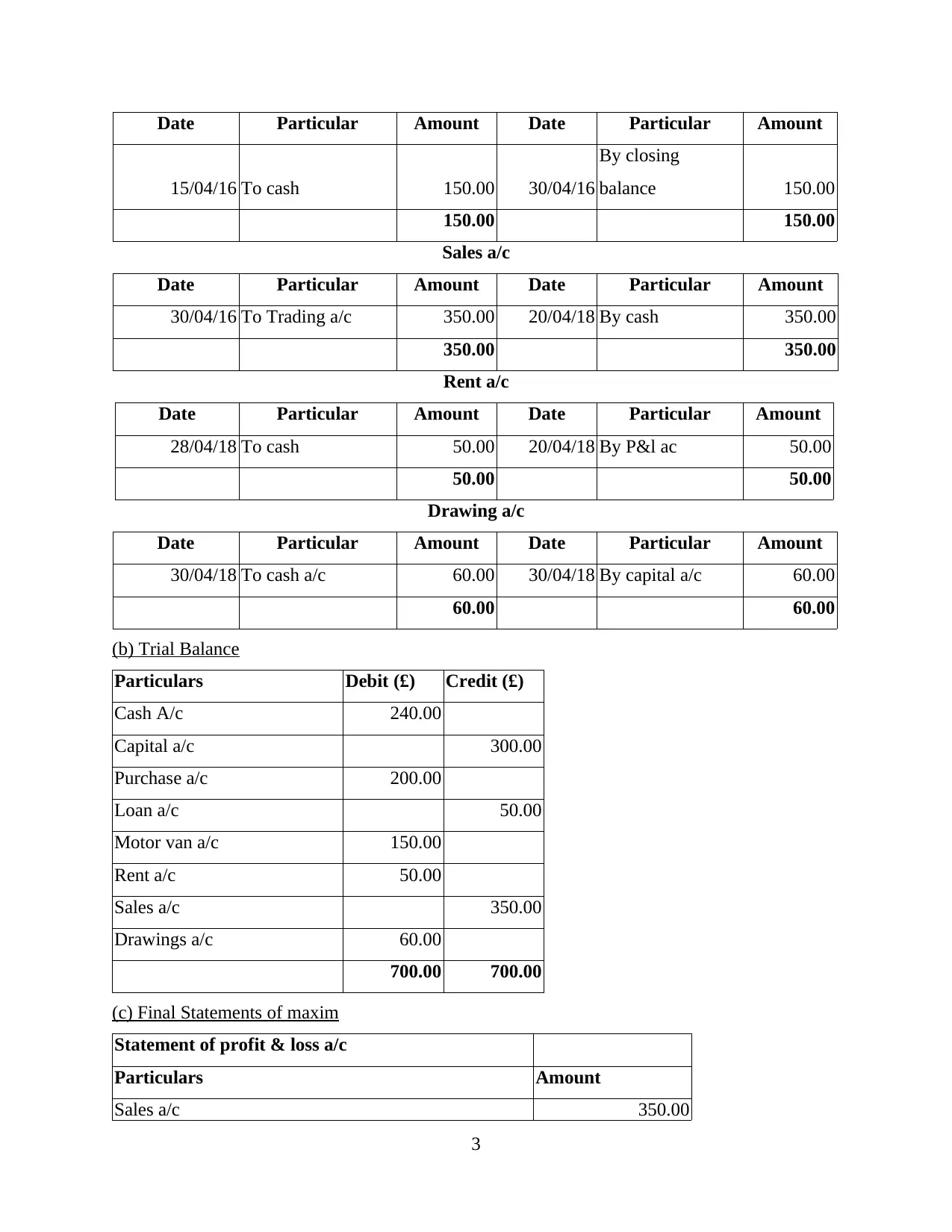
Date Particular Amount Date Particular Amount
15/04/16 To cash 150.00 30/04/16
By closing
balance 150.00
150.00 150.00
Sales a/c
Date Particular Amount Date Particular Amount
30/04/16 To Trading a/c 350.00 20/04/18 By cash 350.00
350.00 350.00
Rent a/c
Date Particular Amount Date Particular Amount
28/04/18 To cash 50.00 20/04/18 By P&l ac 50.00
50.00 50.00
Drawing a/c
Date Particular Amount Date Particular Amount
30/04/18 To cash a/c 60.00 30/04/18 By capital a/c 60.00
60.00 60.00
(b) Trial Balance
Particulars Debit (£) Credit (£)
Cash A/c 240.00
Capital a/c 300.00
Purchase a/c 200.00
Loan a/c 50.00
Motor van a/c 150.00
Rent a/c 50.00
Sales a/c 350.00
Drawings a/c 60.00
700.00 700.00
(c) Final Statements of maxim
Statement of profit & loss a/c
Particulars Amount
Sales a/c 350.00
3
15/04/16 To cash 150.00 30/04/16
By closing
balance 150.00
150.00 150.00
Sales a/c
Date Particular Amount Date Particular Amount
30/04/16 To Trading a/c 350.00 20/04/18 By cash 350.00
350.00 350.00
Rent a/c
Date Particular Amount Date Particular Amount
28/04/18 To cash 50.00 20/04/18 By P&l ac 50.00
50.00 50.00
Drawing a/c
Date Particular Amount Date Particular Amount
30/04/18 To cash a/c 60.00 30/04/18 By capital a/c 60.00
60.00 60.00
(b) Trial Balance
Particulars Debit (£) Credit (£)
Cash A/c 240.00
Capital a/c 300.00
Purchase a/c 200.00
Loan a/c 50.00
Motor van a/c 150.00
Rent a/c 50.00
Sales a/c 350.00
Drawings a/c 60.00
700.00 700.00
(c) Final Statements of maxim
Statement of profit & loss a/c
Particulars Amount
Sales a/c 350.00
3
⊘ This is a preview!⊘
Do you want full access?
Subscribe today to unlock all pages.

Trusted by 1+ million students worldwide
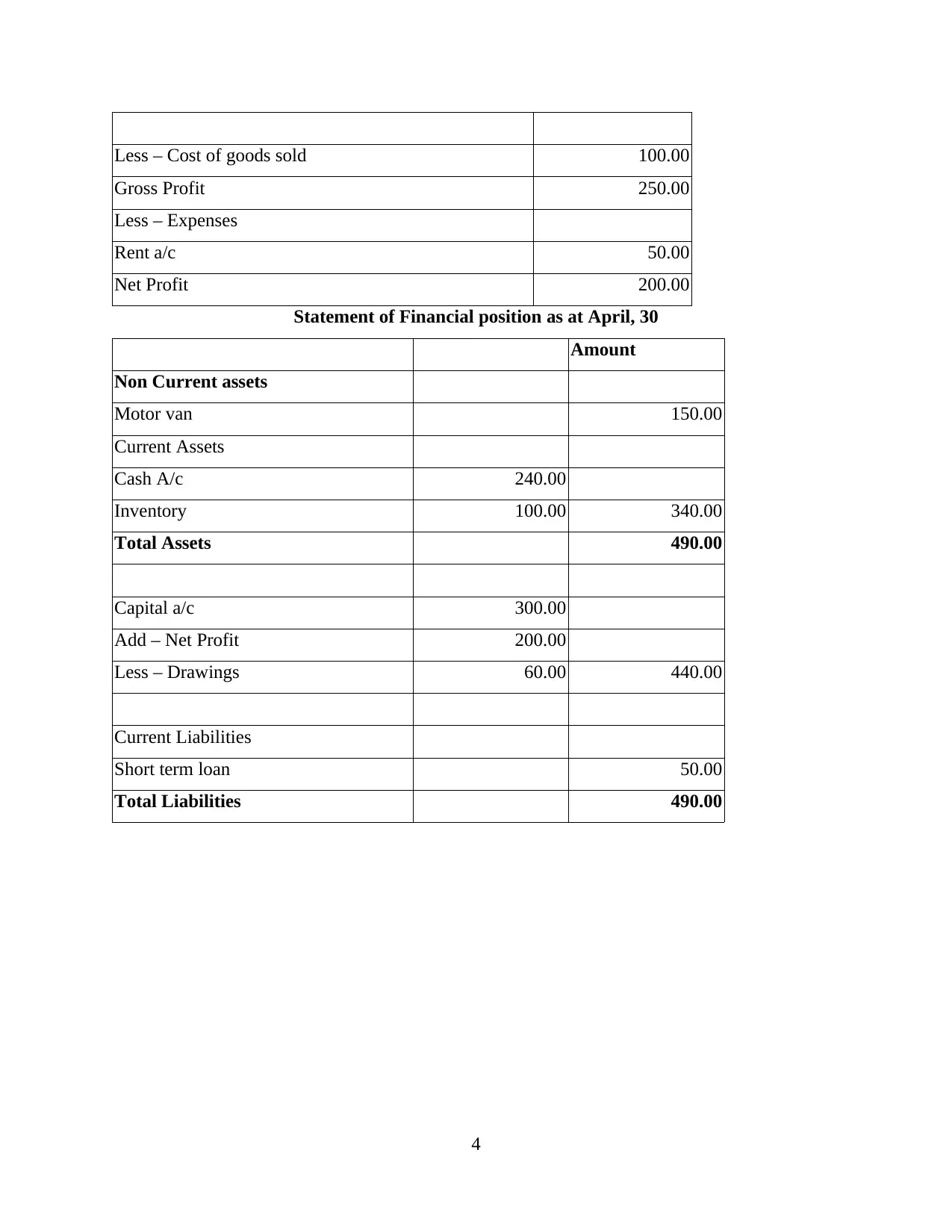
Less – Cost of goods sold 100.00
Gross Profit 250.00
Less – Expenses
Rent a/c 50.00
Net Profit 200.00
Statement of Financial position as at April, 30
Amount
Non Current assets
Motor van 150.00
Current Assets
Cash A/c 240.00
Inventory 100.00 340.00
Total Assets 490.00
Capital a/c 300.00
Add – Net Profit 200.00
Less – Drawings 60.00 440.00
Current Liabilities
Short term loan 50.00
Total Liabilities 490.00
4
Gross Profit 250.00
Less – Expenses
Rent a/c 50.00
Net Profit 200.00
Statement of Financial position as at April, 30
Amount
Non Current assets
Motor van 150.00
Current Assets
Cash A/c 240.00
Inventory 100.00 340.00
Total Assets 490.00
Capital a/c 300.00
Add – Net Profit 200.00
Less – Drawings 60.00 440.00
Current Liabilities
Short term loan 50.00
Total Liabilities 490.00
4
Paraphrase This Document
Need a fresh take? Get an instant paraphrase of this document with our AI Paraphraser
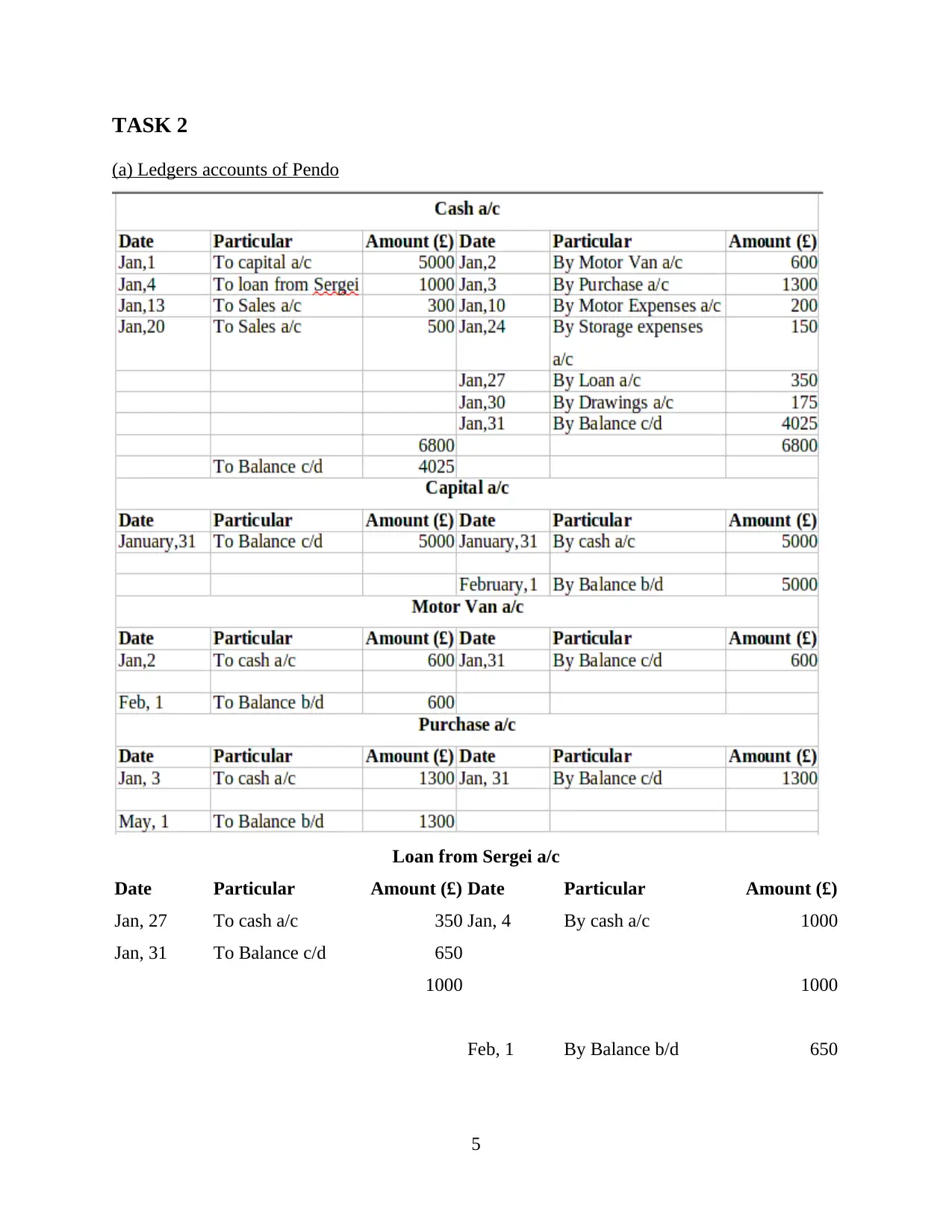
TASK 2
(a) Ledgers accounts of Pendo
Loan from Sergei a/c
Date Particular Amount (£) Date Particular Amount (£)
Jan, 27 To cash a/c 350 Jan, 4 By cash a/c 1000
Jan, 31 To Balance c/d 650
1000 1000
Feb, 1 By Balance b/d 650
5
(a) Ledgers accounts of Pendo
Loan from Sergei a/c
Date Particular Amount (£) Date Particular Amount (£)
Jan, 27 To cash a/c 350 Jan, 4 By cash a/c 1000
Jan, 31 To Balance c/d 650
1000 1000
Feb, 1 By Balance b/d 650
5
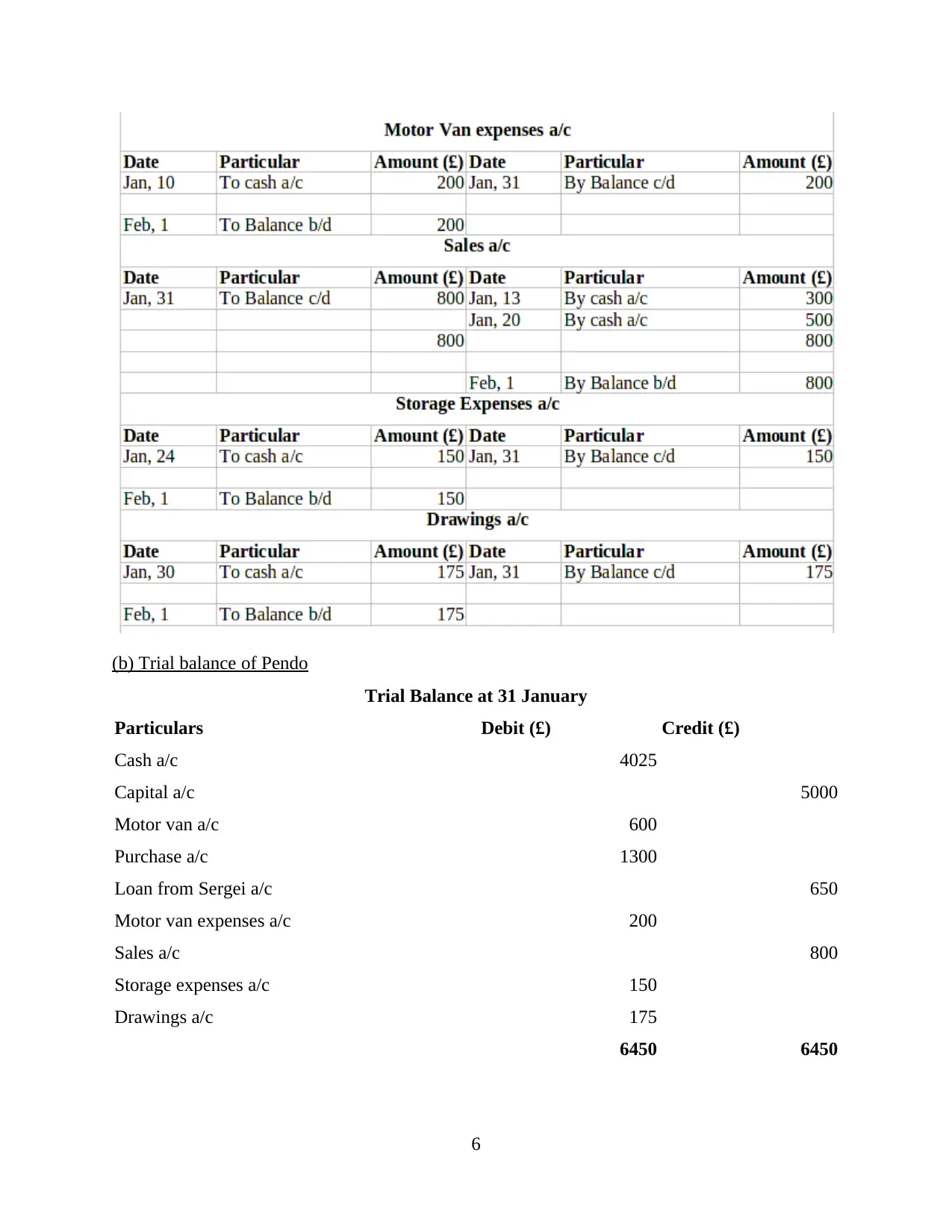
(b) Trial balance of Pendo
Trial Balance at 31 January
Particulars Debit (£) Credit (£)
Cash a/c 4025
Capital a/c 5000
Motor van a/c 600
Purchase a/c 1300
Loan from Sergei a/c 650
Motor van expenses a/c 200
Sales a/c 800
Storage expenses a/c 150
Drawings a/c 175
6450 6450
6
Trial Balance at 31 January
Particulars Debit (£) Credit (£)
Cash a/c 4025
Capital a/c 5000
Motor van a/c 600
Purchase a/c 1300
Loan from Sergei a/c 650
Motor van expenses a/c 200
Sales a/c 800
Storage expenses a/c 150
Drawings a/c 175
6450 6450
6
⊘ This is a preview!⊘
Do you want full access?
Subscribe today to unlock all pages.

Trusted by 1+ million students worldwide
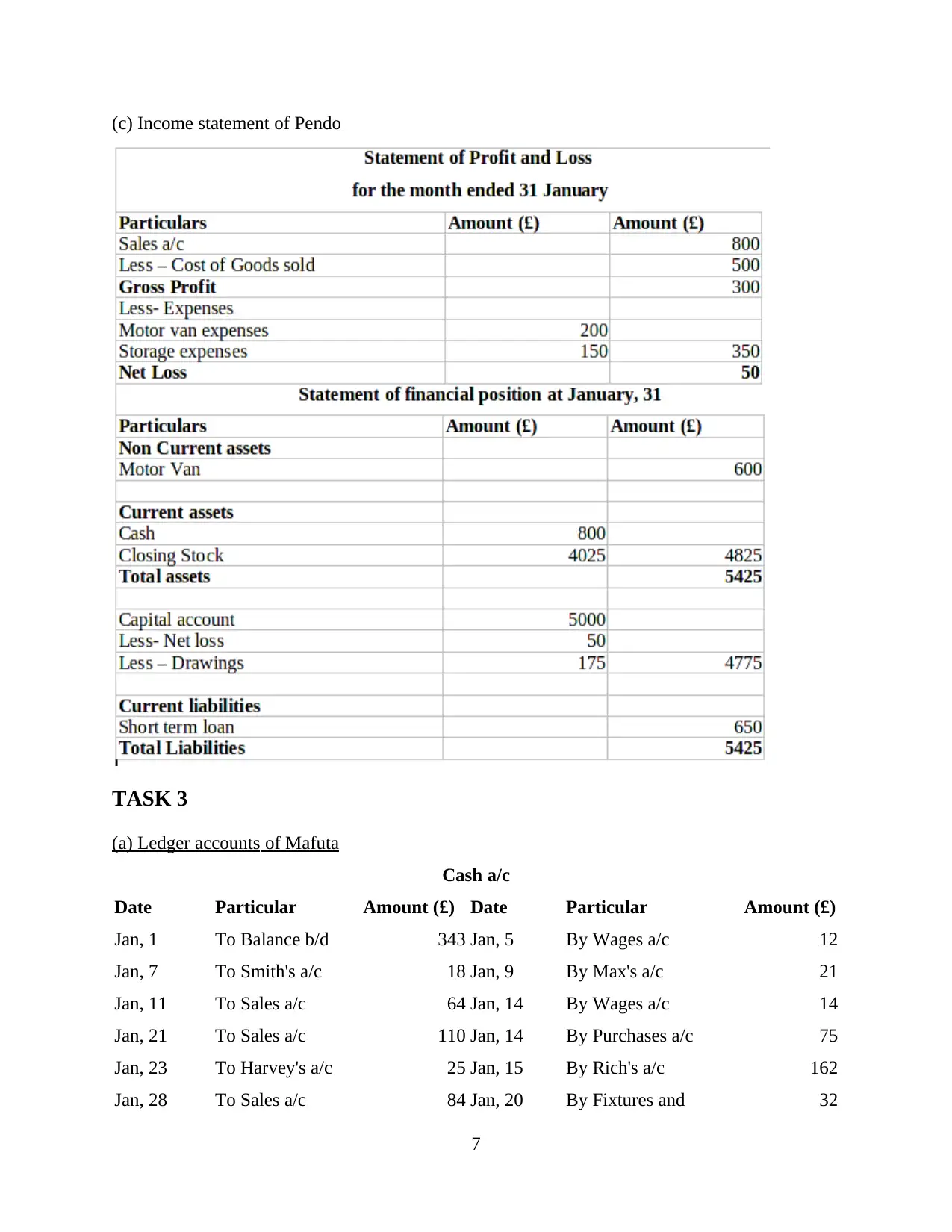
(c) Income statement of Pendo
TASK 3
(a) Ledger accounts of Mafuta
Cash a/c
Date Particular Amount (£) Date Particular Amount (£)
Jan, 1 To Balance b/d 343 Jan, 5 By Wages a/c 12
Jan, 7 To Smith's a/c 18 Jan, 9 By Max's a/c 21
Jan, 11 To Sales a/c 64 Jan, 14 By Wages a/c 14
Jan, 21 To Sales a/c 110 Jan, 14 By Purchases a/c 75
Jan, 23 To Harvey's a/c 25 Jan, 15 By Rich's a/c 162
Jan, 28 To Sales a/c 84 Jan, 20 By Fixtures and 32
7
TASK 3
(a) Ledger accounts of Mafuta
Cash a/c
Date Particular Amount (£) Date Particular Amount (£)
Jan, 1 To Balance b/d 343 Jan, 5 By Wages a/c 12
Jan, 7 To Smith's a/c 18 Jan, 9 By Max's a/c 21
Jan, 11 To Sales a/c 64 Jan, 14 By Wages a/c 14
Jan, 21 To Sales a/c 110 Jan, 14 By Purchases a/c 75
Jan, 23 To Harvey's a/c 25 Jan, 15 By Rich's a/c 162
Jan, 28 To Sales a/c 84 Jan, 20 By Fixtures and 32
7
Paraphrase This Document
Need a fresh take? Get an instant paraphrase of this document with our AI Paraphraser

fittings a/c
Jan, 31 To Sales a/c 31 Jan, 21 By Wages a/c 17
Jan, 23 By office expenses a/c 3
Jan, 28 By Wages a/c 15
Jan, 31 By Balance c/d 323
674 674
Feb, 1 To Balance b/d 323
Capital a/c
Date Particular Amount (£) Date Particular Amount (£)
Jan, 1 To Payables 33 Jan, 1 By Cash in hand a/c 343
Jan, 31 To balance c/d 1049 By Inventory 458
By Furniture and
fittings 198
By Receivables 83
1082 1082
Fixtures and fittings a/c
Date Particular Amount (£) Date Particular Amount (£)
Jan, 1 To Balance b/d 198 Jan, 31 By Balance c/d 230
Jan, 20 To cash a/c 32
230 230
Feb, 1 To Balance b/d 230
Sales a/c
Date Particular Amount (£) Date Particular Amount (£)
Jan, 31 To Trading a/c 412 Jan, 2 By Harvey's a/c 124
Jan, 11 By Cash a/c 64
Jan, 21 By Cash a/c 110
Jan, 28 By Cash a/c 84
Jan, 31 By Cash a/c 30
412 412
Wages a/c
Date Particular Amount (£) Date Particular Amount (£)
8
Jan, 31 To Sales a/c 31 Jan, 21 By Wages a/c 17
Jan, 23 By office expenses a/c 3
Jan, 28 By Wages a/c 15
Jan, 31 By Balance c/d 323
674 674
Feb, 1 To Balance b/d 323
Capital a/c
Date Particular Amount (£) Date Particular Amount (£)
Jan, 1 To Payables 33 Jan, 1 By Cash in hand a/c 343
Jan, 31 To balance c/d 1049 By Inventory 458
By Furniture and
fittings 198
By Receivables 83
1082 1082
Fixtures and fittings a/c
Date Particular Amount (£) Date Particular Amount (£)
Jan, 1 To Balance b/d 198 Jan, 31 By Balance c/d 230
Jan, 20 To cash a/c 32
230 230
Feb, 1 To Balance b/d 230
Sales a/c
Date Particular Amount (£) Date Particular Amount (£)
Jan, 31 To Trading a/c 412 Jan, 2 By Harvey's a/c 124
Jan, 11 By Cash a/c 64
Jan, 21 By Cash a/c 110
Jan, 28 By Cash a/c 84
Jan, 31 By Cash a/c 30
412 412
Wages a/c
Date Particular Amount (£) Date Particular Amount (£)
8
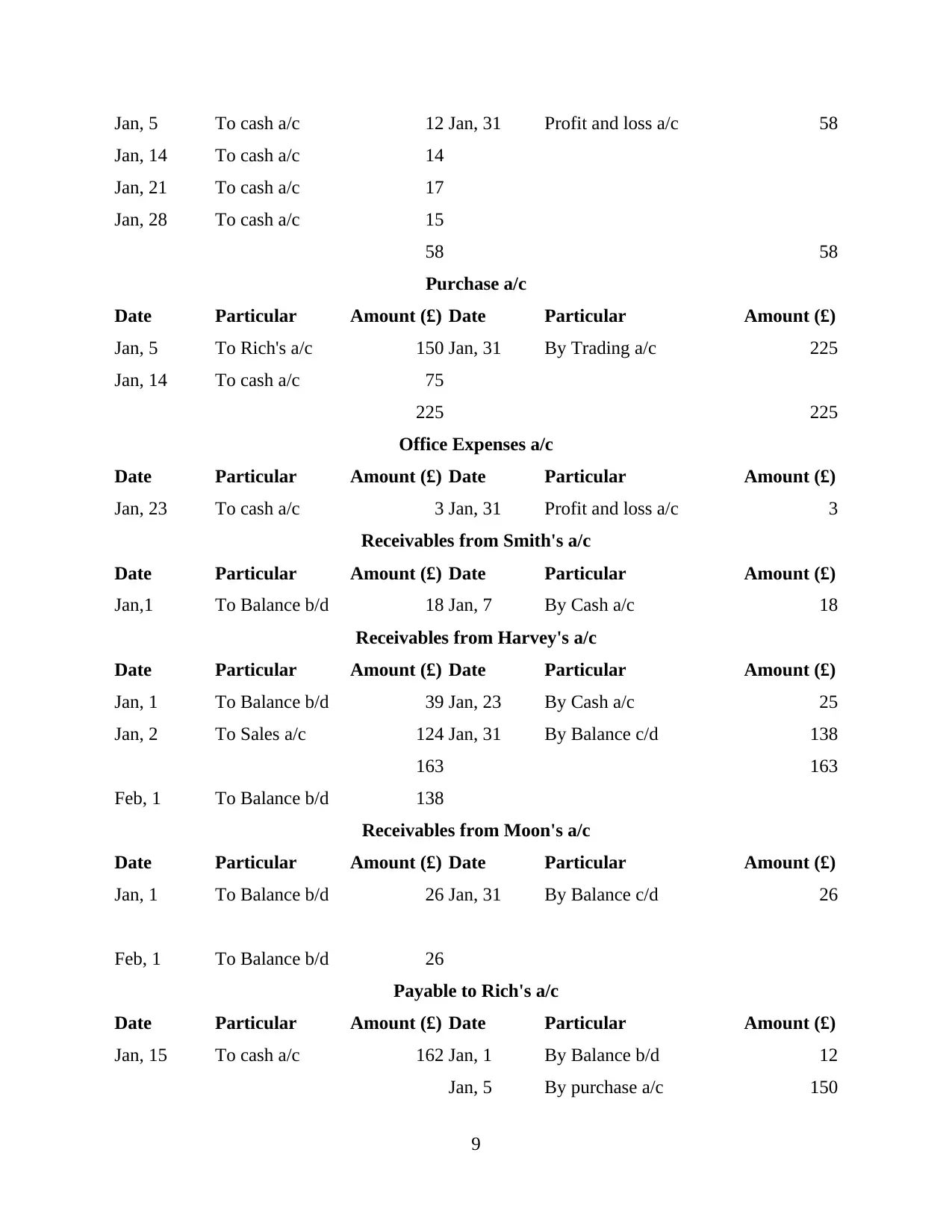
Jan, 5 To cash a/c 12 Jan, 31 Profit and loss a/c 58
Jan, 14 To cash a/c 14
Jan, 21 To cash a/c 17
Jan, 28 To cash a/c 15
58 58
Purchase a/c
Date Particular Amount (£) Date Particular Amount (£)
Jan, 5 To Rich's a/c 150 Jan, 31 By Trading a/c 225
Jan, 14 To cash a/c 75
225 225
Office Expenses a/c
Date Particular Amount (£) Date Particular Amount (£)
Jan, 23 To cash a/c 3 Jan, 31 Profit and loss a/c 3
Receivables from Smith's a/c
Date Particular Amount (£) Date Particular Amount (£)
Jan,1 To Balance b/d 18 Jan, 7 By Cash a/c 18
Receivables from Harvey's a/c
Date Particular Amount (£) Date Particular Amount (£)
Jan, 1 To Balance b/d 39 Jan, 23 By Cash a/c 25
Jan, 2 To Sales a/c 124 Jan, 31 By Balance c/d 138
163 163
Feb, 1 To Balance b/d 138
Receivables from Moon's a/c
Date Particular Amount (£) Date Particular Amount (£)
Jan, 1 To Balance b/d 26 Jan, 31 By Balance c/d 26
Feb, 1 To Balance b/d 26
Payable to Rich's a/c
Date Particular Amount (£) Date Particular Amount (£)
Jan, 15 To cash a/c 162 Jan, 1 By Balance b/d 12
Jan, 5 By purchase a/c 150
9
Jan, 14 To cash a/c 14
Jan, 21 To cash a/c 17
Jan, 28 To cash a/c 15
58 58
Purchase a/c
Date Particular Amount (£) Date Particular Amount (£)
Jan, 5 To Rich's a/c 150 Jan, 31 By Trading a/c 225
Jan, 14 To cash a/c 75
225 225
Office Expenses a/c
Date Particular Amount (£) Date Particular Amount (£)
Jan, 23 To cash a/c 3 Jan, 31 Profit and loss a/c 3
Receivables from Smith's a/c
Date Particular Amount (£) Date Particular Amount (£)
Jan,1 To Balance b/d 18 Jan, 7 By Cash a/c 18
Receivables from Harvey's a/c
Date Particular Amount (£) Date Particular Amount (£)
Jan, 1 To Balance b/d 39 Jan, 23 By Cash a/c 25
Jan, 2 To Sales a/c 124 Jan, 31 By Balance c/d 138
163 163
Feb, 1 To Balance b/d 138
Receivables from Moon's a/c
Date Particular Amount (£) Date Particular Amount (£)
Jan, 1 To Balance b/d 26 Jan, 31 By Balance c/d 26
Feb, 1 To Balance b/d 26
Payable to Rich's a/c
Date Particular Amount (£) Date Particular Amount (£)
Jan, 15 To cash a/c 162 Jan, 1 By Balance b/d 12
Jan, 5 By purchase a/c 150
9
⊘ This is a preview!⊘
Do you want full access?
Subscribe today to unlock all pages.

Trusted by 1+ million students worldwide
1 out of 21
Related Documents
Your All-in-One AI-Powered Toolkit for Academic Success.
+13062052269
info@desklib.com
Available 24*7 on WhatsApp / Email
![[object Object]](/_next/static/media/star-bottom.7253800d.svg)
Unlock your academic potential
Copyright © 2020–2025 A2Z Services. All Rights Reserved. Developed and managed by ZUCOL.





